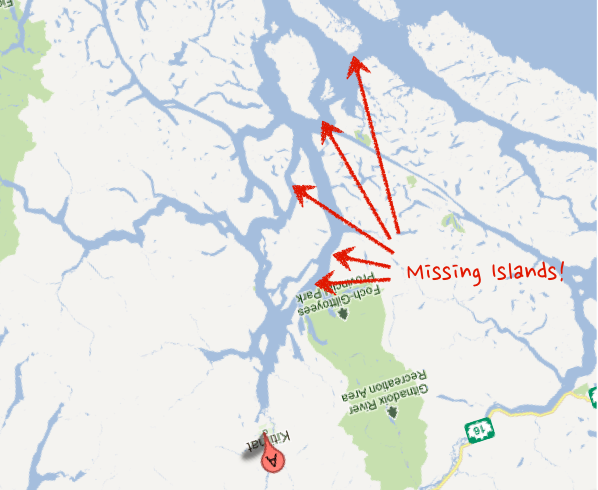My gosh there is a lot going on. Republicans – REPUBLICANS(!) who were in charge of America’s prison system are warning Canada not to follow the Conservatives plan on prisons, the Prime Minister has renamed the government, after himself and my friends at Samara had in Toronto the Guardian’s Emily Bell to talk wikileaks and data journalism (wish I could have been there).
It’s all very interesting… and there is a media story here in British Columbia that’s been brewing where a number of journalists have become upset about a government that has become “too” transparent.
It’s an important case as it highlights some of the tensions that will be emerging in different places as governments rethink how they share information.
The case involves BC Ferries, a crown corporation that runs ferries along critical routes around the province. For many years the company was not subject to the province’s Freedom of Information legislation. However, a few months ago the government stated the crown corporation would need to comply with the act. This has not pleased the corporation’s president.
To comply with the act BC Ferries has created an FOI tracker website on which it posts the text of FOI requests received. Once the records are processed they are posted online and some relevant listservs. As a result they can be read by an audience (that cares).
Broadly, journalists, are up in arms for two reasons. One bad, the other even worse.
The terrible reasons was raised by Chad Skelton (who’s a great reporter for whom I have a lot of respect and whose column should be read regularly).
Skelton argues that BC Ferries deserves part of the blame for stories with errors as the process lead news agencies to rush (carelessly) in order to beat each other in releasing the story. This is a disappointing position. It’s the news media’s job to get the facts right. (It’s also worth noting here that Skelton’s own media organizations did not make the mistakes in question). Claiming that BC Ferries is even partly responsible seems beyond problematic since they are in no way involved in the fact and error checking processes. We trust the media (and assess it) to get facts right in fast moving situations… why should this be different?
More interesting is the critique that this model of transparency undermines the ability of journalists to get a scoup and thus undermines the business model of traditional media.
What makes this so interesting is that is neither true nor, more importantly, relevant.
First, it’s not the job of government to support the business model of the media. The goal of government should be to be as transparent as possible about its operations. This can, and should, include its FOI requests. Indeed, one thing I like about this process is that an FOI request that is made but isn’t addressed starts to linger on the site – and that the organization can be held to account, publicly, for the delay. More importantly, however, I’m confident that the media will find new ways to exploit the process and that, while painful, new business models will emerge.
Second, the media is not the only user of FOI. It strikes me as problematic to expect that the FOI system should somehow be tailored to meet needs alone. Individuals, non-profits, businesses, opposition politicians and others all use the FOI process. Indeed, the policy strengthens many of these use cases since, as mentioned above, delays in processing will be visible and open the organization up to greater pressure and scrutiny. Why are all the use cases of these other institutions somehow secondary to those of journalists and the media? Indeed, the most important use case – that of the citizen – is better served. Isn’t that the most important outcome?
Third, this form of transparency could make for better media. One of my favourite quotes (which I got via Tim O’Reilly) comes from Clayton Christensen in a 2005 Harvard Business Review article:
“When attractive profits disappear at one stage in the value chain because a product becomes modular and commoditized, the opportunity to earn attractive profits with proprietary products will usually emerge at an adjacent stage.”
So BC Ferries has effectively commoditized FOI requests. That simply means that value will shift elsewhere. One place it could shift to is analysis. And wouldn’t that be a good thing to have the media compete on? Rather than simply who got the fact fastest (a somewhat silly model in the age of the internet) readers instead started to reward the organization with the best insights? Indeed, it makes me think that on superficial issues, like say, the salary of an employee, it may be hard for one individual or organization to scoop another. But most often the value of these stories is also pretty low. On a more significant story, one that requires research and digging and a knowledge of the issue, it’s unclear that transparency around FOI requests will allow others to compete. More interestingly, some media organizations, now that they have access to all FOI requests, might start analyzing them for deeper more significant patterns or trends that might reveal more significant problems that the current scattered approach to FOI might never reveal.
What’s also been interesting is the reaction stories by journalists complaining about this issue have been received. It fits nicely in with the piece I wrote a while ago (and now published as part of a journalism textbook) about Journalism in an Open Era. The fact is, the public trust of opaque institutions is in decline – and the media is itself a pretty opaque institution. Consider these three separate comments people wrote after the stories I’ve linked to above:
“I wonder over the years how many nuggets of information reporters got through FOI but the public never heard about because they didn’t deem it “newsworthy”. Or worse, that it was newsworthy but didn’t follow their storyline.” (found here)
“And the media whining about losing scoops — well, tough beans. If they post it all online and give it to everyone, they are serving the public –the media isn’t the public, and never has been.” (found here)
“The media’s track record, in general, for owning up to its blunders continues to be abysmal. Front page screw-ups are fixed several days (or weeks) later with a little “setting it straight” box buried at the bottom of P. 2 — and you think that’s good enough. If the media were more open and honest about fixing its mistakes, I might cut you a little slack over the BC Ferries’ policy of making your life difficult. But whining about it is going to be counterproductive, as you can see from most of the comments so far.” (found here)
While some comments were supportive of the articles, the majority have not been. Suggesting that at the minimum that the public does not share the media’s view that this new policy is a “controversial.”
This is not, of course, to say that BC Ferries implemented its policy because it sought to do the right thing. I’m sure it’s president would love for their to be fewer requests and impede the efforts of journalists. I just happen to think he will fail. Dismally. More concerning is the fact that FOI requests are not archived on the site and are removed after a few months. This is what should get the media, the public and yes, the Information and Privacy Commissioner, up in arms.




 In a month where our federal government cited imaginary data to justify policies on crime and has eliminated the gathering a huge swaths of effective data necessary for the efficient governing of our cities and rural communities as well as ensuring critical services will no longer reach innumerable Canadians, it is nice to see a province trying to do the opposite: not only understand that effective data is the cornerstone to good policy but to enable everyday, ordinary Canadians to leverage it so as to make smarter decisions, influence policy debates and empower themselves. It’s what a modern democracy, economy and civil society should look like.
In a month where our federal government cited imaginary data to justify policies on crime and has eliminated the gathering a huge swaths of effective data necessary for the efficient governing of our cities and rural communities as well as ensuring critical services will no longer reach innumerable Canadians, it is nice to see a province trying to do the opposite: not only understand that effective data is the cornerstone to good policy but to enable everyday, ordinary Canadians to leverage it so as to make smarter decisions, influence policy debates and empower themselves. It’s what a modern democracy, economy and civil society should look like.